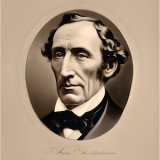The Bottle Neck Page #3
"The Bottle Neck" is a short story by Hans Christian Andersen that details the lifetime adventures of a bottle. Beginning its life as a container of wine, the bottle experiences many incarnations: a buoy at sea, a bird’s home, a corner decoration in a poor man's room. Its life ends trapped in a mason’s wall, only to be discovered years later with a message that carries a lot of significance for its finder. This story is a reflection on life's journey and the significance of past experiences.
thought the bottle, "men go on a journey that they may see as much as possible, and I can see nothing." However, it did something quite as important; it travelled to the place of its destination, and was unpacked. "What trouble they have taken with that bottle over yonder!" said one, "and very likely it is broken after all." But the bottle was not broken, and, better still, it understood every word that was said: this language it had heard at the furnaces and at the wine merchant's; in the forest and on the ship,--it was the only good old language it could understand. It had returned home, and the language was as a welcome greeting. For very joy, it felt ready to jump out of people's hands, and scarcely noticed that its cork had been drawn, and its contents emptied out, till it found itself carried to a cellar, to be left there and forgotten. "There's no place like home, even if it's a cellar." It never occurred to him to think that he might lie there for years, he felt so comfortable. For many long years he remained in the cellar, till at last some people came to carry away the bottles, and ours amongst the number. Out in the garden there was a great festival. Brilliant lamps hung in festoons from tree to tree; and paper lanterns, through which the light shone till they looked like transparent tulips. It was a beautiful evening, and the weather mild and clear. The stars twinkled; and the new moon, in the form of a crescent, was surrounded by the shadowy disc of the whole moon, and looked like a gray globe with a golden rim: it was a beautiful sight for those who had good eyes. The illumination extended even to the most retired of the garden walks, at least not so retired that any one need lose himself there. In the borders were placed bottles, each containing a light, and among them the bottle with which we are acquainted, and whose fate it was, one day, to be only a bottle neck, and to serve as a water-glass to a bird's-cage. Everything here appeared lovely to our bottle, for it was again in the green wood, amid joy and feasting; again it heard music and song, and the noise and murmur of a crowd, especially in that part of the garden where the lamps blazed, and the paper lanterns displayed their brilliant colors. It stood in a distant walk certainly, but a place pleasant for contemplation; and it carried a light; and was at once useful and ornamental. In such an hour it is easy to forget that one has spent twenty years in a loft, and a good thing it is to be able to do so. Close before the bottle passed a single pair, like the bridal pair--the mate and the furrier's daughter--who had so long ago wandered in the wood. It seemed to the bottle as if he were living that time over again. Not only the guests but other people were walking in the garden, who were allowed to witness the splendor and the festivities. Among the latter came an old maid, who seemed to be quite alone in the world. She was thinking, like the bottle, of the green wood, and of a young betrothed pair, who were closely connected with herself; she was thinking of that hour, the happiest of her life, in which she had taken part, when she had herself been one of that betrothed pair; such hours are never to be forgotten, let a maiden be as old as she may. But she did not recognize the bottle, neither did the bottle notice the old maid. And so we often pass each other in the world when we meet, as did these two, even while together in the same town. The bottle was taken from the garden, and again sent to a wine merchant, where it was once more filled with wine, and sold to an aeronaut, who was to make an ascent in his balloon on the following Sunday. A great crowd assembled to witness the sight; military music had been engaged, and many other preparations made. The bottle saw it all from the basket in which he lay close to a live rabbit. The rabbit was quite excited because he knew that he was to be taken up, and let down again in a parachute. The bottle, however, knew nothing of the "up," or the "down;" he saw only that the balloon was swelling larger and larger till it could swell no more, and began to rise and be restless. Then the ropes which held it were cut through, and the aerial ship rose in the air with the aeronaut and the basket containing the bottle and the rabbit, while the music sounded and all the people shouted "Hurrah." "This is a wonderful journey up into the air," thought the bottle; "it is a new way of sailing, and here, at least, there is no fear of striking against anything." Thousands of people gazed at the balloon, and the old maid who was in the garden saw it also; for she stood at the open window of the garret, by which hung the cage containing the linnet, who then had no water-glass, but was obliged to be contented with an old cup. In the window-sill stood a myrtle in a pot, and this had been pushed a little on one side, that it might not fall out; for the old maid was leaning out of the window, that she might see. And she did see distinctly the aeronaut in the balloon, and how he let down the rabbit in the parachute, and then drank to the health of all the spectators in the wine from the bottle. After doing this, he hurled it high into the air. How little she thought that this was the very same bottle which her friend had thrown aloft in her honor, on that happy day of rejoicing, in the green wood, in her youthful days. The bottle had no time to think, when raised so suddenly; and before it was aware, it reached the highest point it had ever attained in its life. Steeples and roofs lay far, far beneath it, and the people looked as tiny as possible. Then it began to descend much more rapidly than the rabbit had done, made somersaults in the air, and felt itself quite young and unfettered, although it was half full of wine. But this did not last long. What a journey it was! All the people could see the bottle; for the sun shone upon it. The balloon was already far away, and very soon the bottle was far away also; for it fell upon a roof, and broke in pieces. But the pieces had got such an impetus in them, that they could not stop themselves. They went jumping and rolling about, till at last they fell into the court-yard, and were broken into still smaller pieces; only the neck of the bottle managed to keep whole, and it was broken off as clean as if it had been cut with a diamond. "That would make a capital bird's glass," said one of the cellar-men; but none of them had either a bird or a cage, and it was not to be expected they would provide one just because they had found a bottle neck that could be used as a glass. But the old maid who lived in the garret had a bird, and it really might be useful to her; so the bottle neck was provided with a cork, and taken up to her; and, as it often happens in life, the part that had been uppermost was now turned downwards, and it was filled with fresh water. Then they hung it in the cage of the little bird, who sang and twittered more
Translation
Translate and read this book in other languages:
Select another language:
- - Select -
- 简体中文 (Chinese - Simplified)
- 繁體中文 (Chinese - Traditional)
- Español (Spanish)
- Esperanto (Esperanto)
- 日本語 (Japanese)
- Português (Portuguese)
- Deutsch (German)
- العربية (Arabic)
- Français (French)
- Русский (Russian)
- ಕನ್ನಡ (Kannada)
- 한국어 (Korean)
- עברית (Hebrew)
- Gaeilge (Irish)
- Українська (Ukrainian)
- اردو (Urdu)
- Magyar (Hungarian)
- मानक हिन्दी (Hindi)
- Indonesia (Indonesian)
- Italiano (Italian)
- தமிழ் (Tamil)
- Türkçe (Turkish)
- తెలుగు (Telugu)
- ภาษาไทย (Thai)
- Tiếng Việt (Vietnamese)
- Čeština (Czech)
- Polski (Polish)
- Bahasa Indonesia (Indonesian)
- Românește (Romanian)
- Nederlands (Dutch)
- Ελληνικά (Greek)
- Latinum (Latin)
- Svenska (Swedish)
- Dansk (Danish)
- Suomi (Finnish)
- فارسی (Persian)
- ייִדיש (Yiddish)
- հայերեն (Armenian)
- Norsk (Norwegian)
- English (English)
Citation
Use the citation below to add this book to your bibliography:
Style:MLAChicagoAPA
"The Bottle Neck Books." Literature.com. STANDS4 LLC, 2025. Web. 22 Feb. 2025. <https://www.literature.com/book/the_bottle_neck_2147>.








Discuss this The Bottle Neck book with the community:
Report Comment
We're doing our best to make sure our content is useful, accurate and safe.
If by any chance you spot an inappropriate comment while navigating through our website please use this form to let us know, and we'll take care of it shortly.
Attachment
You need to be logged in to favorite.
Log In